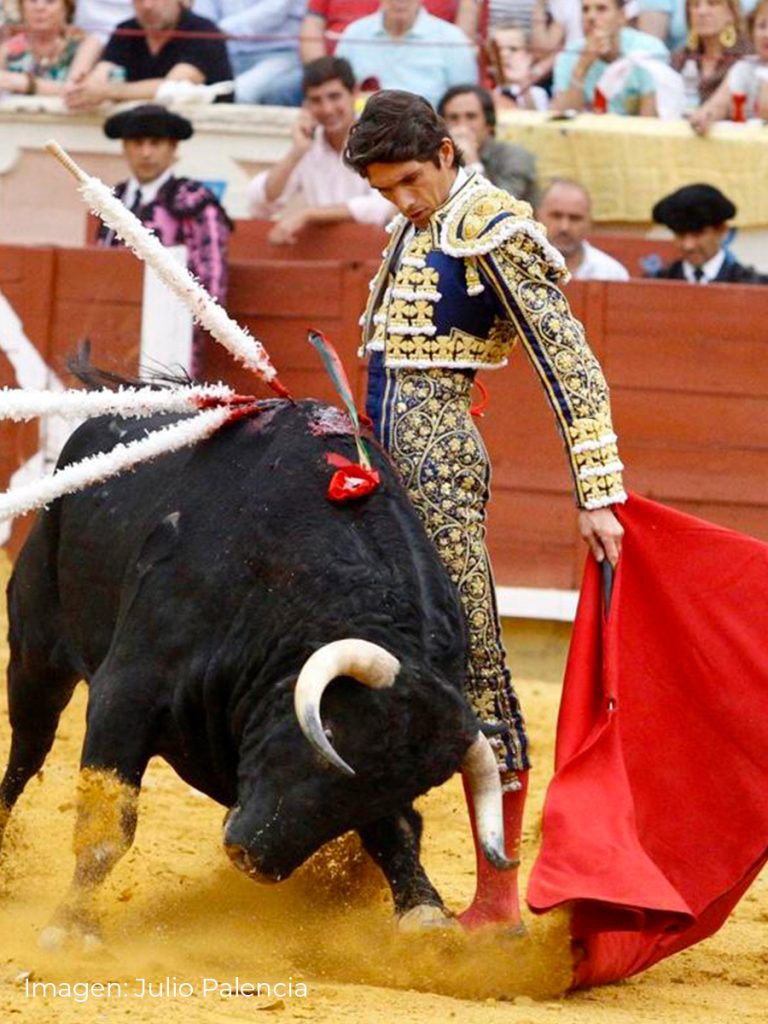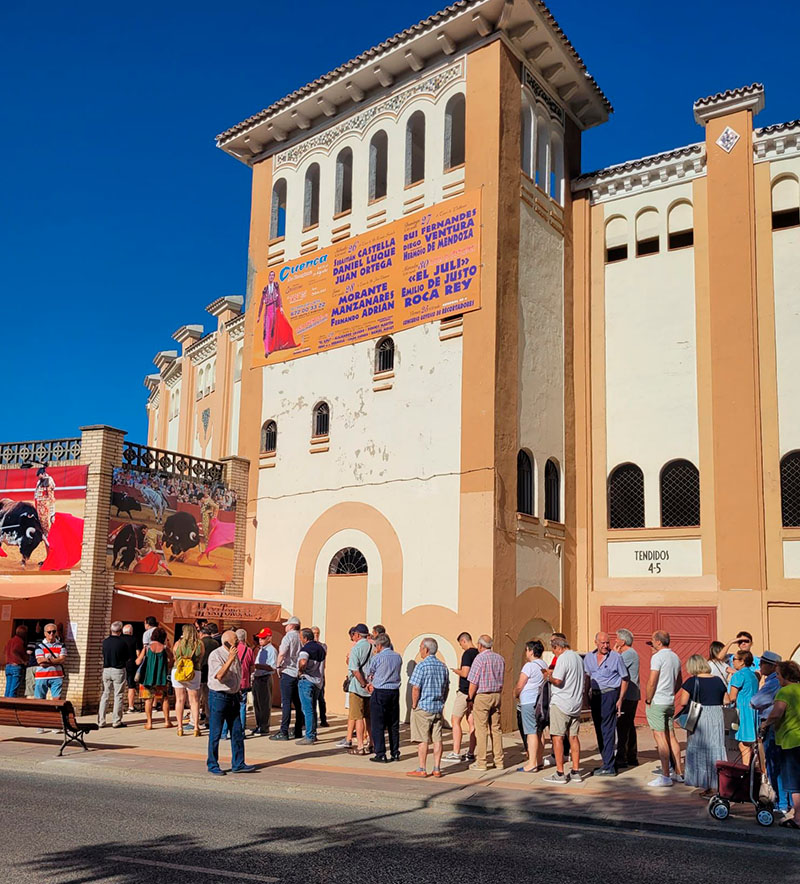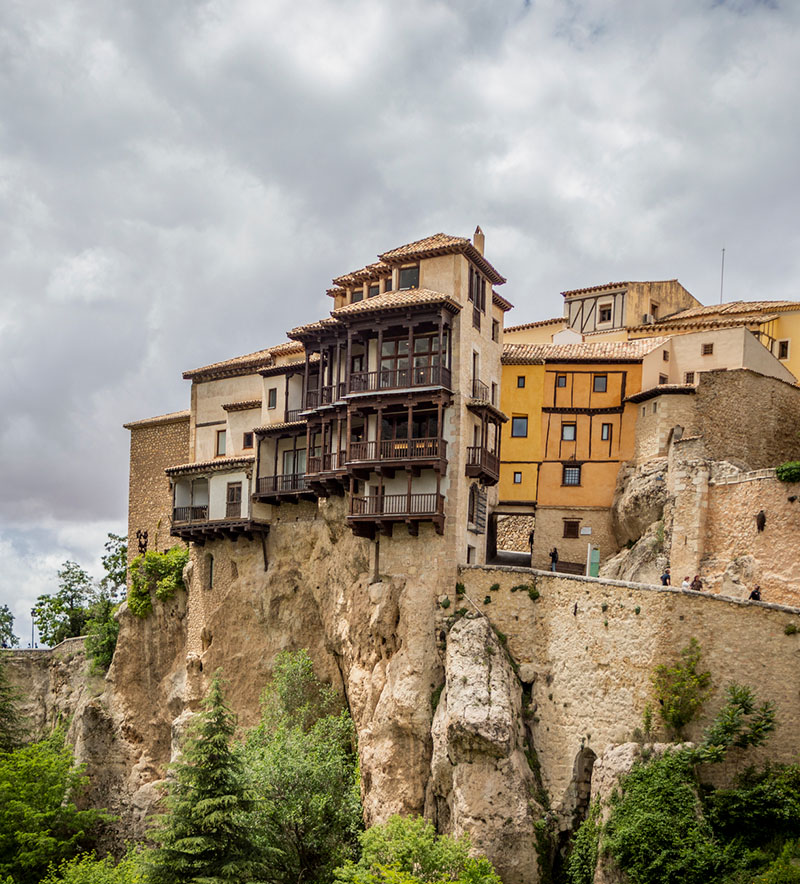-
CUENCA
Every August, during the San Julián Fair, the Cuenca bullring hosts a series of four or five bullfights featuring the leading figures of the bullfighting world. The atmosphere in the stands is unmatched, with the arena filled to capacity every day. Make sure to book your tickets in advance, as demand is extremely high and a full house is always guaranteed.
Every August, during the San Julián Fair, the Cuenca bullring hosts a series of four or five bullfights featuring the leading figures of the bullfighting world. The atmosphere in the stands is unmatched, with the arena filled to capacity every day. Make sure to book your tickets in advance, as demand is extremely high and a full house is always guaranteed.
-
History
Cuenca
Discover the history of the Cuenca Bullring, from its origins in the 17th century to its current role in the San Julián Fair.
Discover the history of the Cuenca Bullring, from its origins in the 17th century to its current role in the San Julián Fair.
-
Seating plan and prices
Cuenca
Looking for tickets to the bullfights in Cuenca? You've come to the right place. Find all the information you need about prices, seat availability and more, so you can enjoy a unique bullfighting experience.
Looking for tickets to the bullfights in Cuenca? You've come to the right place. Find all the information you need about prices, seat availability and more, so you can enjoy a unique bullfighting experience.
Cuenca Bullring: history, fair, how to visit it and why you shouldn't miss it
The Bullring in Cuenca
The Cuenca Bullring is one of the most representative bullfighting venues in Castilla-La Mancha. Located next to the historic centre, this second-category bullring has a capacity for more than 6,000 spectators and every summer becomes the heart of the San Julián Bullfighting Fair, one of the most important events on the Spanish bullfighting calendar.
More than just a venue, the bullring symbolises the cultural and festive spirit of Cuenca, where a passion for bullfighting is part of its identity.
History of the Cuenca Bullring
The origins of bullfighting in Cuenca
The passion for bullfighting in Cuenca runs deep. As early as the 17th century, local festivities and bullfights were held in the Main Square (Plaza Mayor), where temporary wooden stands and barriers were built for spectators. Over time, the growing enthusiasm of the people of Cuenca led to the idea of constructing a permanent bullring — a space that would reflect the city’s strong cultural identity and devotion to this Spanish tradition.
The first bullring: 1848
The first Cuenca bullring was inaugurated in June 1848, on the same site where the current one stands today. It could hold around 5,000 spectators, a remarkable capacity for its time.
That opening day is still remembered for a curious and almost legendary event: one of the bulls, named “Clavellino”, survived the fight after receiving more than thirty sword thrusts. To the astonishment of the crowd, the animal was returned alive to the pen — an extraordinary moment still recalled by veteran aficionados.
A new project: the 1913 bullring
At the beginning of the 20th century, the passion for bullfighting continued to grow, prompting the construction of a new, more modern bullring. In 1913, a new arena was built, designed by the architect Roberto García Ochoa. Unfortunately, its life was short. Due to structural and maintenance problems, it had to be replaced only a few years later.
The current bullring: inaugurated in 1926–1927
The City Council of Cuenca decided to build a new, solid, and lasting structure to meet the demands of the growing audience. The works were completed in 1926, and the official opening took place on 7 September of that year, with bulls from the Santa Coloma ranch for the matadors Marcial Lalanda, Valencia II, and Martín Agüero.
This new Plaza de Toros de Cuenca was designed in a classical and elegant style, with stone and wooden stands, spacious corridors, and a large arena offering excellent visibility from every seat.
Some historical records place the official inauguration during the 1927 San Julián Fair, under the reign of King Alfonso XIII.
Remodelling and modernisation
Over the decades, the bullring has undergone several renovations to improve safety and comfort without losing its historic charm. One of the most notable refurbishments took place on 29 April 1975, when the pens and corrals were expanded to accommodate up to four full bullfights at once.
Today, the building perfectly combines the charm of tradition with the standards of modern comfort, maintaining its distinctive architecture and atmosphere.
A second-category bullring with a conquense soul
La Plaza de Toros de Cuenca está considerada de segunda categoría y cuenta con un aforo actual de más de 8.300 localidades. Cada verano, durante la Feria de San Julián, se convierte en uno de los escenarios taurinos más destacados de Castilla-La Mancha, reuniendo a las principales figuras del toreo y a una afición entusiasta y fiel.
The Cuenca Bullring is officially classified as a second-category arena and can seat over 8,300 spectators. Every summer, during the San Julián Fair, it becomes one of the main bullfighting centres in Castilla-La Mancha, attracting top matadors, renowned ranches, and passionate fans from across Spain and abroad.
Toreros and unforgettable afternoons
Among the bullfighters who have made history in Cuenca, one name stands out: Manuel Jiménez “Chicuelo II”, a true idol of local fans during the 1950s. His elegant and brave style captivated the audience, and one of his performances is still regarded as legendary — the 1954 San Julián Fair bullfight, remembered as a “historic afternoon”, where eight ears, three tails, and three hooves were awarded. That day remains one of the most glorious moments in Cuenca’s bullfighting history.

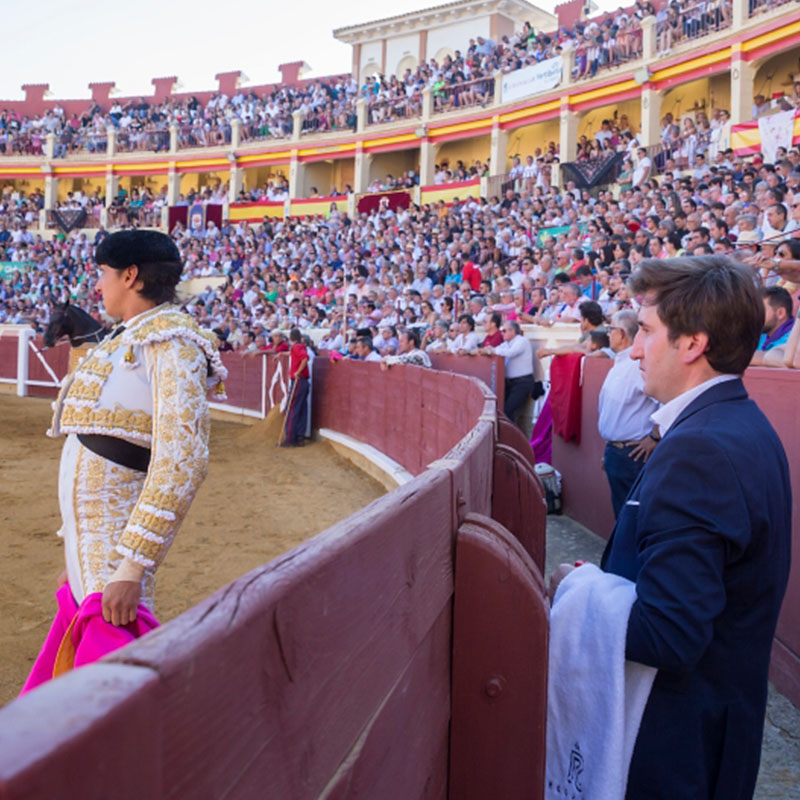

In 1954, eight ears, three tails and three legs were cut off. That afternoon remains vivid in the memory and is remembered as the ‘bullfight of the century’.
The San Julián Bullfighting Fair: the essence of summer in Cuenca
A fair steeped in history and tradition
Every August, the city dresses up to celebrate the San Julián Fair, one of the oldest and most distinctive in Spain. During these days, Cuenca welcomes the leading figures in bullfighting and prominent national livestock breeders.
Posters and atmosphere
The bullfighting posters in Cuenca include cycles of 4-5 shows: bullfights, novilladas (bullfights with young bulls) and an equestrian show. For some years now, it has been known as the ‘Champions’. It manages to fill the arena and hang up the ‘no tickets available’ sign every year. The atmosphere in the stands is unmistakable: familiar, friendly and full of enthusiasm.
A must-see event for fans
The Cuenca Fair has established itself as one of the major summer fairs alongside those in Bilbao, Málaga and Almería, attracting both long-standing enthusiasts and visitors from all over Spain.
USEFUL INFORMATION Plaza de toros de Cuenca
Second Category
Capacity
Subscribers
Major events
Minor performances
A symbol of tradition and culture
Today, the Plaza de Toros de Cuenca is not only a bullfighting venue but also a cultural and architectural landmark of the city. Throughout the year, it hosts concerts, guided tours, and community events, keeping alive the connection between Cuenca’s history and Spanish bullfighting tradition.
Its location, overlooking the Huécar Gorge and the UNESCO-listed old town, makes it one of the most atmospheric bullrings in Spain — a place where art, bravery, and history meet under the summer sun of Castilla-La Mancha.
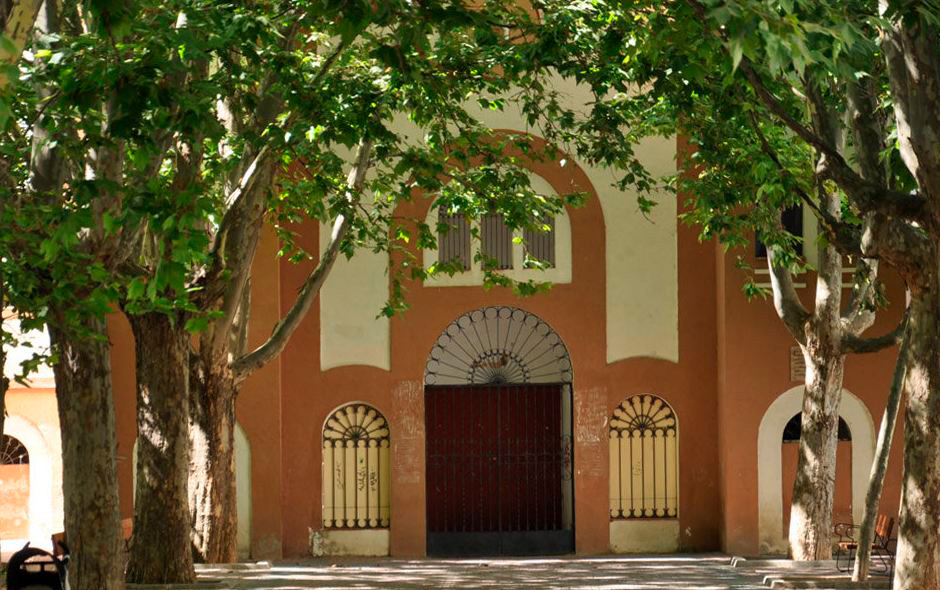
Entradas Plaza de Toros de Cuenca: cómo comprar y asistir
Tickets for the Cuenca Bullfighting Fair usually sell out shortly after going on sale. The local passion for bullfighting is immense, and no one wants to miss the shows held during these days.
It’s worth noting that there is a large number of season ticket holders (fans who purchase passes for all the events), which means that individual tickets for each day are very limited.
We recommend booking your tickets in advance, either at the official box office of the bullring or through Servitoro, an authorised sales channel where you can easily choose your preferred section and row.
Tickets are sent in PDF format directly to your email inbox, ready to print.

Seating plan
Second Floor:
Rows 1-4
Front Row
First Floor:
Rows 1-4
Front Row
Stands:
Rows 6-9
Rows 1-5
Back Barrier
Barrier
Useful tips to enjoy the full experience
- Experience a bullfight during the San Julián Fair to feel the authentic atmosphere.
- If you are looking for greater comfort, choose shaded seats.
- For families, novilladas (bullfights with young bulls) or rejones (bullfights on horseback) are ideal.
- Arrive early to avoid crowds. (1 hour before the show)
- Bring your tickets in PDF format printed on paper to avoid queues.
- Remember that once the paseíllo has begun, you will not be allowed to take your seat.
- You can get up between bulls.
- If you are sitting in the sun, bring a hat, fan, sun cream and water.
- Combine your visit with a stroll through the Hanging Houses and a typical Cuenca meal.
Bullfighting tickets in Cuenca
Purchase your tickets for the bullfights in Cuenca with Servitoro and experience an unforgettable San Juan Fair.


